Reports
Renewed Activity at the Sanjarian and Golab Dareh Amad Sites
by David Albright, Spencer Faragasso, and the Good ISIS Team
September 12, 2024
During the last year and a half, Iran has reportedly reactivated and accelerated activities at two former Amad Plan sites that were key to Iran’s development of nuclear weapons during its crash nuclear weapons program in the early 2000s, according to Western intelligence officials who decided to release officially the information to the Institute on the condition of remaining anonymous. The two sites, Sanjarian and Golab Dareh, were central to the Amad Plan’s development of a sophisticated multipoint initiation (MPI) system to initiate the high explosives for spherical implosion in a nuclear weapon, to develop and test high-speed diagnostic equipment or their subcomponents, and to conduct a range of tests to ensure that the MPI system and diagnostic equipment worked. 1
The officials emphasized that this recent activity is being conducted by experts in the Organization of Defensive Innovation and Research (aka SPND or SEPAND) who participated in weaponization work in the Amad Plan. SPND is a DARPA-like defense entity, which evolved from the Amad Plan, and still holds many of the personnel and material assets of the Amad Plan and is widely viewed as the locus of Iranian work on nuclear weaponization. The former AMAD personnel involved at these two sites appear to have freedom of action within SPND.
The suspicious activities at Sanjarian and Golab Dareh are more concerning since, if nuclear weapons-related, they would be occurring hand-in-hand with the enormous progress in Iran’s uranium enrichment programs, verified by the International Atomic Energy Agency (IAEA) and then assessed by the Institute, to have the ability to shorten breakout timelines for the production of weapon-grade uranium to about a week. Recent statements by senior Iranian officials about changing Iran’s nuclear doctrine only add concern about this suspicious activity. 2
Details about the specific suspicious activities reportedly being conducted at the two sites were not provided. However, it was said to have included high explosive tests and technical research and development of a sensitive nature. A concern is that the activities could be bridging technical gaps in Iran’s nuclear weapons program.
Satellite imagery does show increased, and ongoing, personnel presence to support any renewed operations at the Sanjarian site, along with recent observable improvements to its physical security and site landscaping. However, at Golab Dareh, operational activity has not yet been observed. Nonetheless, the Golab Dareh site had previously been limited to explosive test operations within an arched roof bunker and a building housing a high velocity gun system for equation-of-state experiments. Even when fully operational in the early 2000s, little to no activity would have been observed externally as was shown in Nuclear Archive ground photos of the Golab Dareh site during that time. 3
Recent media reports have reported that Iran has advanced its work on nuclear weapons. The most recent U.S. intelligence statement on Iran’s nuclear weapons program is that it has “undertaken activities that better position it to produce a nuclear device.” 4 The officials emphasized that this change in language reflects Iranian work on nuclear weapons rather than Iran’s advanced ability to produce weapon-grade uranium quickly. These new revelations may shed light on some of the underpinnings of this new assessment.
In addition to possibly advancing Iran’s nuclear weapons program, the work at the two sites could be a violation of Section T of the Joint Comprehensive Plan of Action (JCPOA). This JCPOA section addresses concerns about activities relevant to potential nuclear weaponization, specifically requiring Iran not to engage in specific activities, which could “contribute to the design and development of a nuclear explosive device.” In particular, section T requires a declaration, approval of a non-nuclear purpose by the executive agency of the JCPOA, and monitoring of (1) any designing, developing, fabricating, acquiring, or using multi-point explosive detonation, aka MPI, systems suitable for a nuclear explosive device, or (2) designing, developing, fabricating, acquiring, or using explosive diagnostic systems (streak cameras, framing cameras, and flash x-ray cameras) suitable for the development of a nuclear explosive device. Several Section T activities were conducted at Sanjarian and possibly Golab Dareh during the Amad Plan.
Ideally, in order to assess whether a safeguards or Section T violation is occurring, the IAEA should evaluate the latest information and ask to visit the sites and interview Iranian personnel. In the absence of any real chance for a visit, the IAEA should at least evaluate the information as part of broader reporting about determining the completeness of Iran’s nuclear declaration under its comprehensive safeguards agreement.
Sanjarian Site
The Sanjarian site, about 20 kilometers east of Tehran, was a key Amad testing and manufacturing facility, particularly associated with the development and testing of the “shock wave generator,” 5 a sophisticated multipoint initiation system, exploding bridgewires, and diagnostic equipment for MPI system testing. It also produced the high explosive PETN used in the shock wave generator channels.
The key nuclear weapons activities at the Sanjarian site took place in two specialized chambers inside the main building and thus were not visible from outside. However, the Nuclear Archive, obtained from Iran by Israel in a clandestine operation in 2018, contains extensive documentation on what occurred inside the chambers. For example, the chambers were used to conduct 136 tests in a seven-month period from September 2002 to April 2003, out of a total of 189 tests conducted at Amad’s four main nuclear weapons component development and testing sites in that same time-period.
Documents in the Nuclear Archive laid out the Iranian plan in 2003 to either keep Sanjarian operational or move its assets and workforce to other sites. The nuclear weapons capabilities at Sanjarian were a unique asset, according to Iran’s Nuclear Archive, nonexistent at other Iranian defense sites. Preserving these capabilities and the workforce was a priority for the post-Amad reorientation plan.
The nuclear weapons related activity at Sanjarian may have continued until 2009, when it was first exposed publicly. Afterwords, a very low level of activity was maintained at this site continuously up until January 2021, as evidenced by Google Earth satellite images of the Sanjarian facility, scrutinized by the Institute. 6
Then suddenly during the time of a purported “TV film shoot” for an Iranian show called Nun Kh, across the ravine in 2021, multiple passenger vehicles began being seen parked outside the main gate on a regular basis (see Figure 1). 7 However, tree plantings were added along both sides of the entrance road all the way from the compound to the main highway between March 5, 2022 and June 1, 2022, and a probable security gate after May 4, 2023.
The officials stated the renewed activity in 2023 and 2024 involved elements in SPND, which participated in the Amad Plan. But the activity is being done without the coordination of the management of SPND, which is acting more cautiously. The officials emphasized that the suspicious activities are being conducted inside closed buildings and by implication cannot be determined precisely by outside observation.
During the last year and a half, commercial satellite imagery does show renewed and intensified activity, as exhibited by the increased presence of personnel vehicles and related site improvements, although the activities inside the buildings cannot be determined from the imagery. Nonetheless, the site is operational and very active, given the cleanliness of the site, the installation of a new probable checkpoint gate, the recent addition of tree landscaping along the entrance road leading into it, and most importantly the ever-changing number and type of passenger vehicles that are parked outside the entrance gate on an ongoing basis. In at least one image, a probable vehicle can be seen parked inside the site’s compound. It is a highly secure facility with only limited vehicular access.
Figures 2-6 show this renewed activity. Figure 2 is an image of the site soon after the closure of the Amad Plan. Subsequent images, taken from May to August 2024, show this renewed activity.
Golab Dareh
The Golab Dareh site is small and surrounded by other military facilities in the southern part of the Parchin military complex, including an explosive handling facility that apparently serves at least two nearby ballistic development test facilities (Figure 7). The site consists of one main bunker with an L-shaped earthen berm, and a second, smaller bunker. Figure 8 shows the site as it was shortly after the end of the Amad Plan, along with a Nuclear Archive ground image of the site during the Amad Plan.
During the Amad Plan, this site was engaged in equation of state experiments, including metal flyer plate and velocity experiments. It was also involved in testing photodiodes. Over the seven-month period discussed above, the site conducted a total of 41 tests out of a total of 189 conducted at the four Amad sites during this period. Since the Amad Plan, the site has changed very little; commercial satellite imagery shows only infinitesimal changes to the site since 2010. 8
According to the latest information, in the last year and a half, the site has “awoken.” Several SPND experts who were part of the weaponization group of Amad have conducted explosive testing at the site. It is technical research and development of a sensitive nature. The official said that these tests were done in an uncontrolled and negligent manner in contradiction of the procedures of SPND. The SPND experts appear to have freedom of action within SPND.
Using a sample of commercial satellite imagery in the last year, the Institute found no observable evidence of any activity in the immediate area of the Golab Dareh Nuclear Weapons Development Site. It cannot be ruled out that Iran conducted some additional experiments inside the bunker, but there is no obvious external manifestation that such testing has occurred. But, for the record, this was also the case earlier when, as indicated by the ground photos of the bunker that the Institute published two years ago; the ground photos showed no exterior evidence of explosive testing, but the interior of the bunker showed innumerable ejecta divots. 9 Additionally, commercial satellite imagery only provides a momentary snapshot, and any visible activities may have occurred outside the window when the images were taken. With constant visual monitoring capabilities, advanced states may have seen much more.
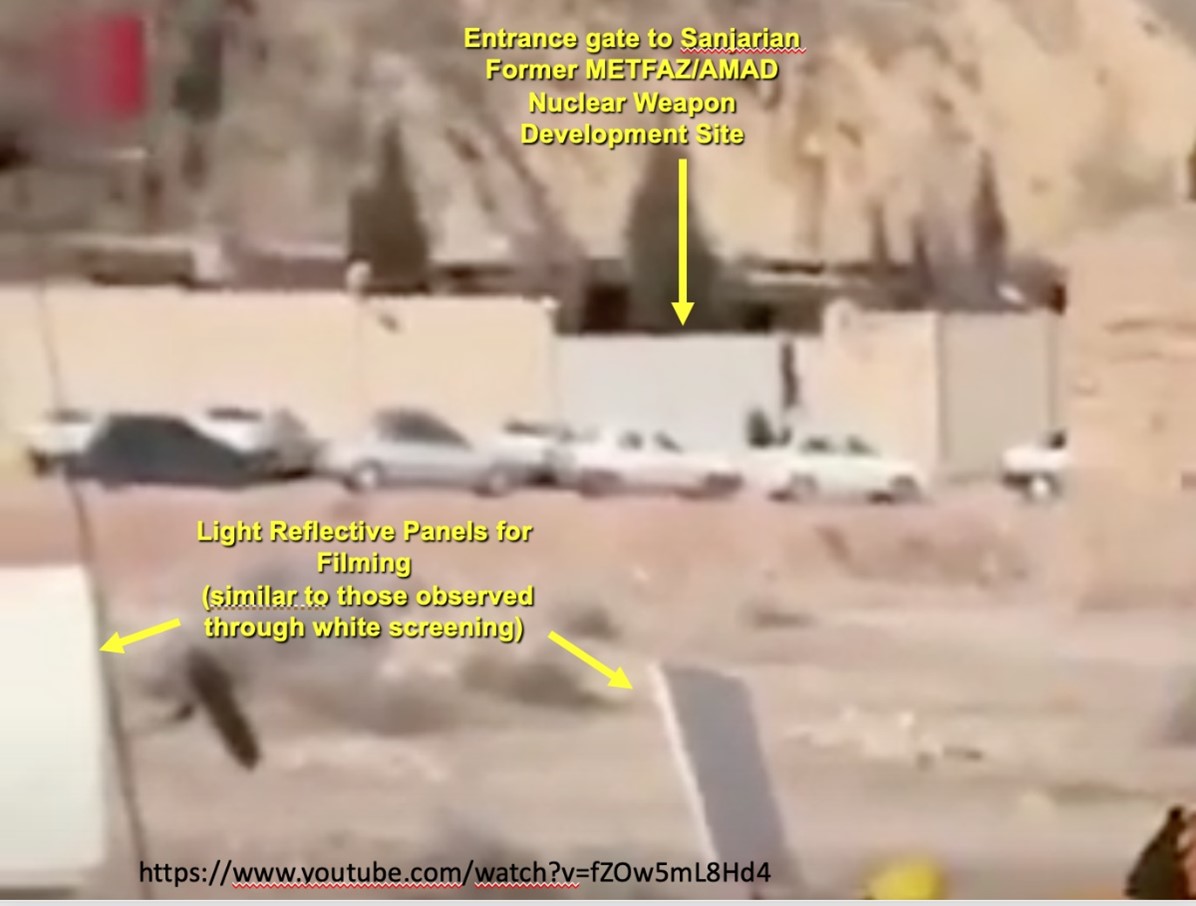
Figure 1. A view of the gate entrance to the Sanjarian facility from a purported TV film for the Iranian show, Nun Kh, set across the ravine. 10 Many vehicles are seen parked outside the entrance. Supposed reflective lighting panels can be seen in the foreground. 11
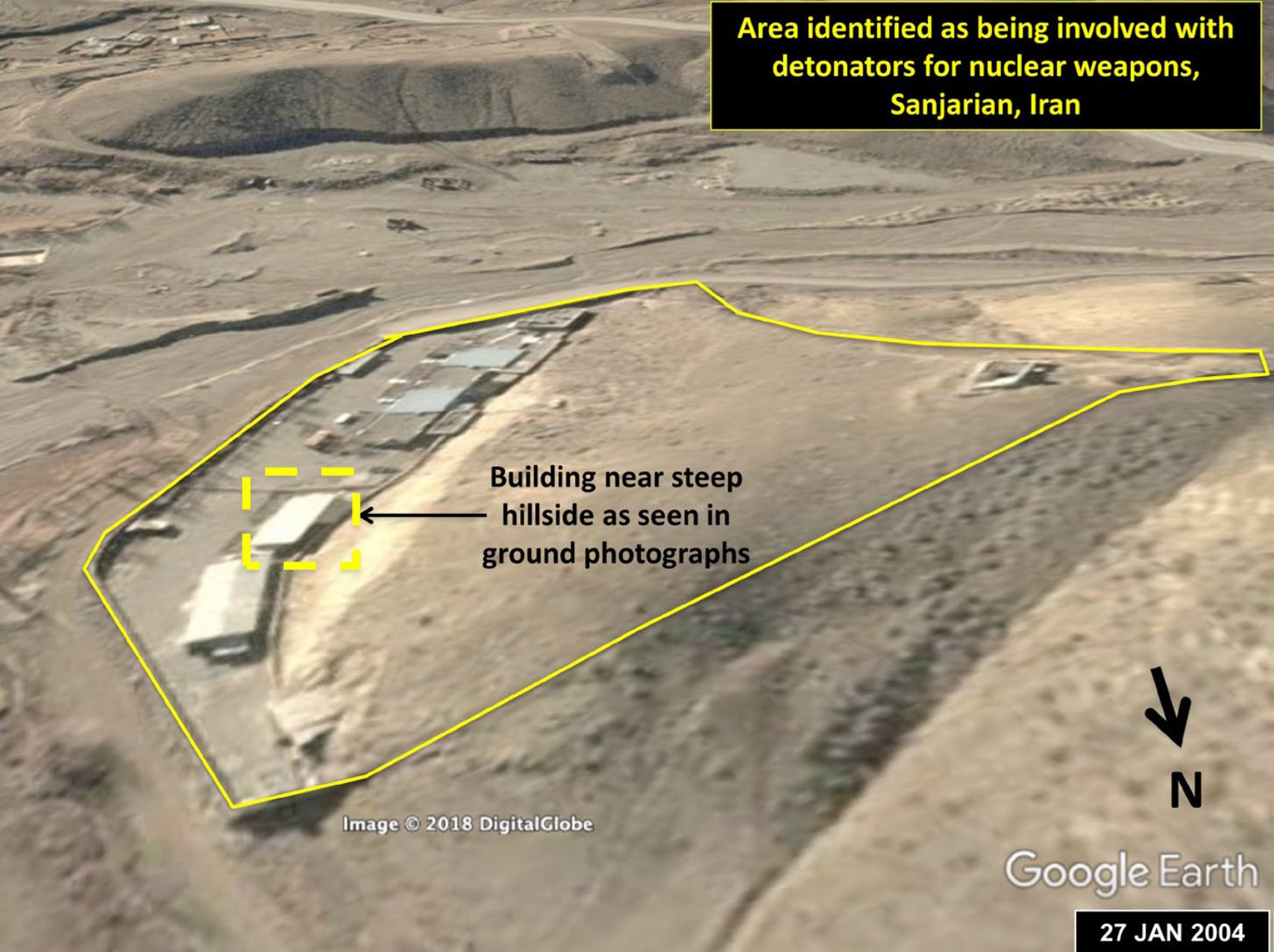
Figure 2. The Sanjarian complex of buildings. The building outlined in yellow contained the two chambers used for testing nuclear weapons components and diagnostic equipment components.
Figure 3. The upper image shows the Sanjarian site in May 2023, showing limited activity. The bottom image from one year later shows many vehicles and a new probable outer security checkpoint gate.
Figure 4. These images, taken June 19 and July 10, 2024, show a number of vehicles and possibly the internal security gate open.
Figure 5. No activity is visible on July 15, 2024. This day was an Iranian national public holiday called Tassoua, a day off for the general population, with schools and most businesses closed.
Figure 6. An image of August 3, 2024, showing the locations of the new roadside tree plantings.
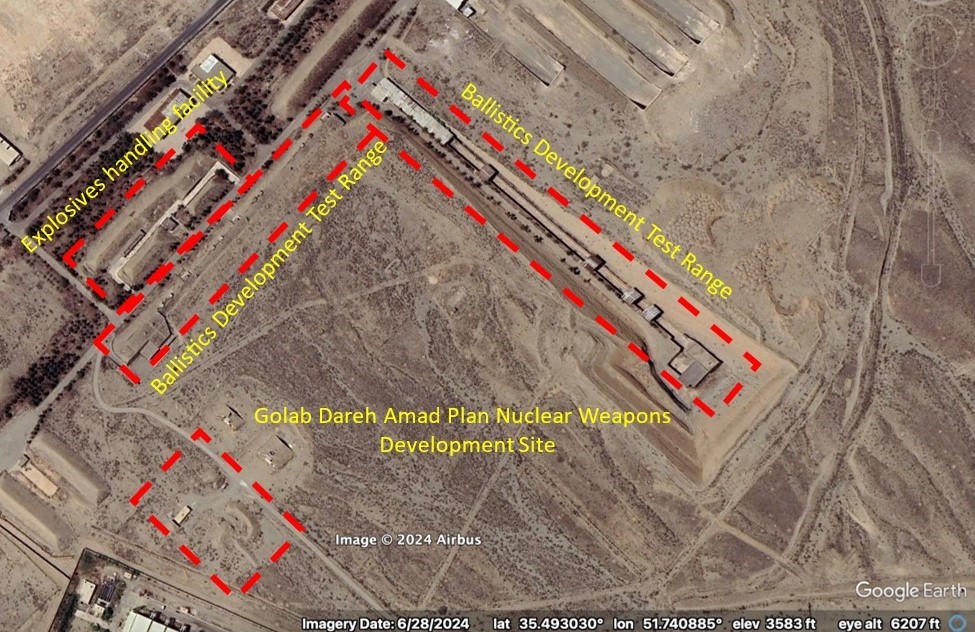
Figure 7. The Golab Dareh Site in June 2024 among other military sites at the Parchin complex.
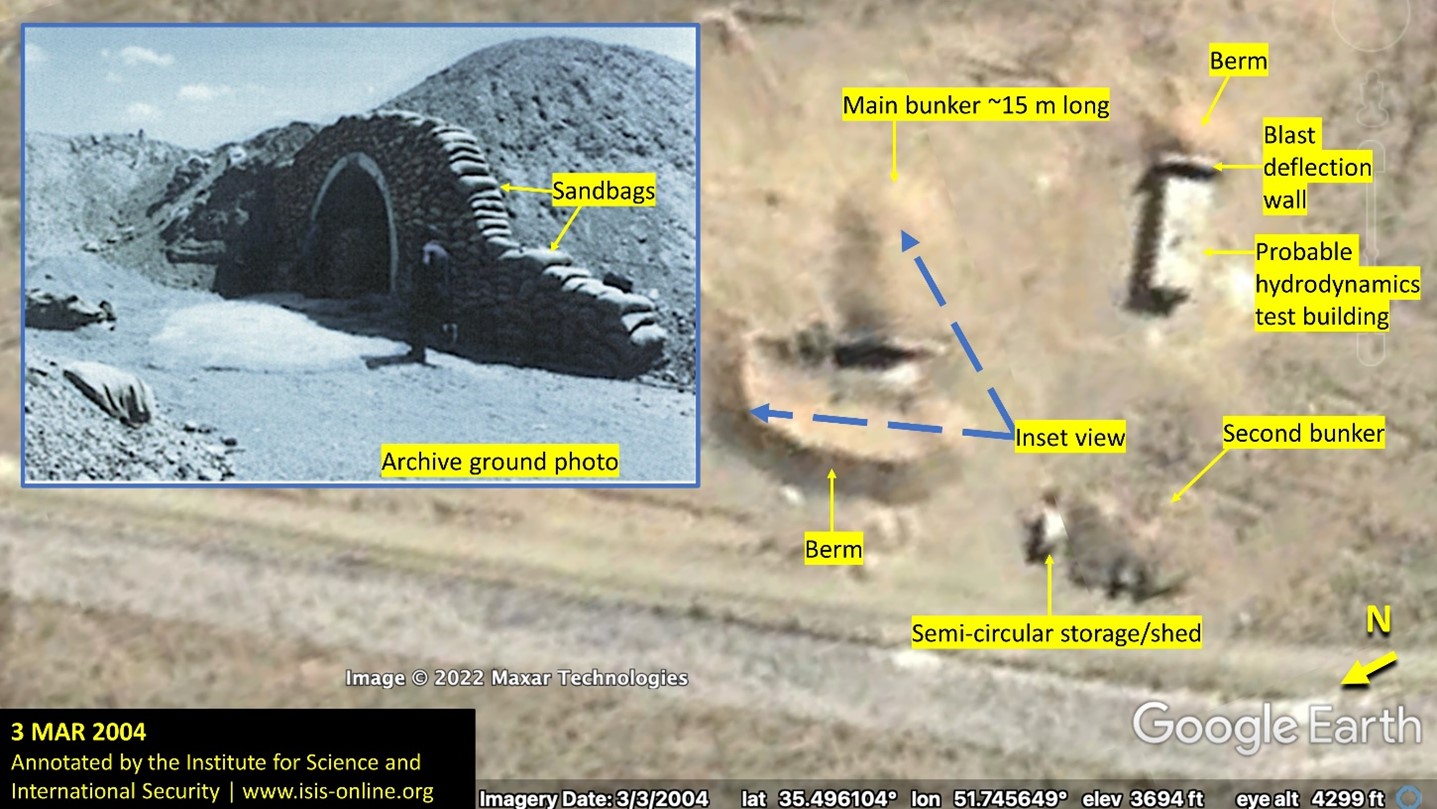
Figure 8. The Golab Dareh site in March 2004 featured a large bunker and a building suitable for nuclear-weapons related testing and developing high-speed diagnostic equipment.
1. David Albright with Sarah Burkhard and the Good ISIS Team, Iran’s Perilous Pursuit of Nuclear Weapons (Washington, D.C.: Institute for Science and International Security Press, 2021), Chapter 4. ↩
2. “Iran to change nuclear doctrine if existence threatened, adviser to supreme leader says,” Reuters, May 9, 2024, https://www.reuters.com/world/middle-east/iran-change-nuclear-doctrine-if-existence-threatened-adviser-supreme-leader-says-2024-05-09/. ↩
3. Iran’s Perilous Pursuit of Nuclear Weapons; or David Albright and Sarah Burkhard, “The Fourth Nuclear-Weapons-Related Testing Site Located: Another Parchin Site, More Undeclared Nuclear Material Possible, Institute for Science and International Security, September 7, 2022, https://isis-online.org/isis-reports/detail/the-fourth-nuclear-weapons-related-testing-site-located. ↩
4. Office of the Director of National Intelligence, “Iran’s Nuclear Weapons Capability and Terrorism Monitoring Act of 2022,” July 2024, https://www.dni.gov/files/ODNI/documents/assessments/ODNI-Unclassified-Irans-Nuclear-Weapons-Capability-and-Terrorism-Monitoring-Act-of-2022-202407.pdf. ↩
5. Iran’s Perilous Pursuit of Nuclear Weapons, or David Albright and Olli Heinonen, “Shock Wave Generator for Iran’s Nuclear Weapons Program: More than a Feasibility Study,” Institute for Science and International Security, May 7, 2019, https://isis-online.org/isis-reports/detail/shock-wave-generator-for-irans-nuclear-weapons-program-more-than-a-feasibil. ↩
6. “Shock Wave Generator for Iran’s Nuclear Weapons Program: More than a Feasibility Study.” ↩
7. David Albright and Sarah Burkhard, “Just What is Going on at Sanjarian?,” Institute for Science and International Security, June 14, 2021, https://isis-online.org/isis-reports/detail/just-what-is-going-on-at-sanjarian/. ↩
8. The sandbag wall, visible in the ground image in Figure 7, was removed after 2004 but before 2009. ↩
9. David Albright and Sarah Burkhard, “The Fourth Nuclear-Weapons-Related Testing Site Located: Another Parchin Site, More Undeclared Nuclear Material Possible,” Institute for Science and International Security, September 7, 2022, https://isis-online.org/isis-reports/detail/the-fourth-nuclear-weapons-related-testing-site-located/8. ↩
10. “Fox News confuses TV series filming set with other activities in Iran,” Tehran Times, June 13, 2021, https://www.tehrantimes.com/news/461948/Fox-News-confuses-TV-series-filming-set-with-other-activities. ↩
11. “پشت صحنه نون خ 3 که قرار است در ایام نوروز 1400 از تلویزیون پخش شو,” YouTube, February 16, 2021, https://web.archive.org/web/20210614094839/https://www.youtube.com/watch?v=fZOw5mL8Hd4. ↩


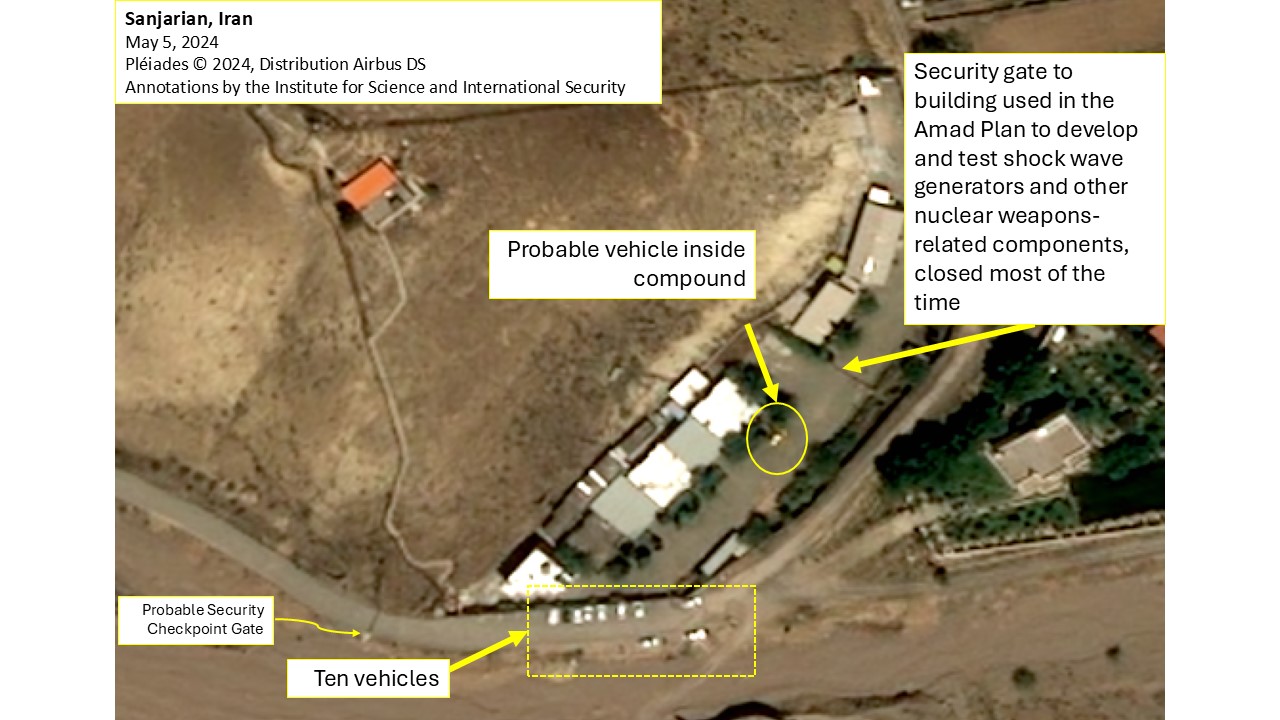
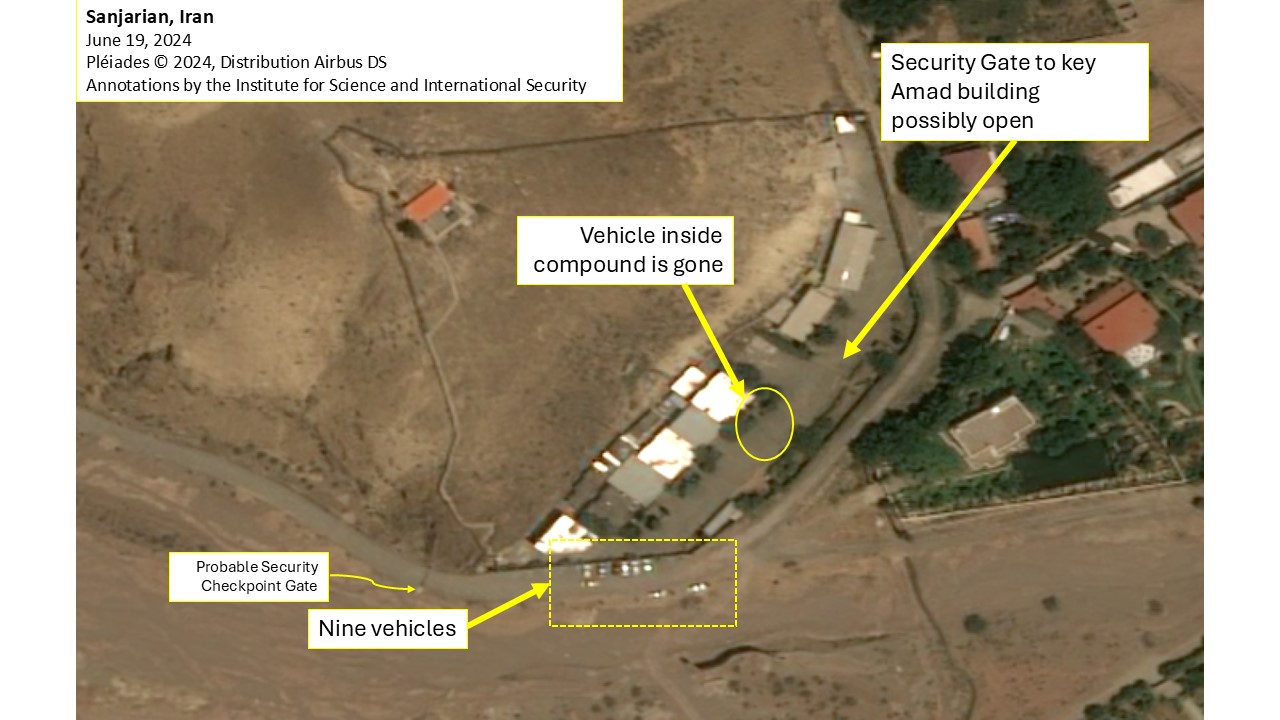
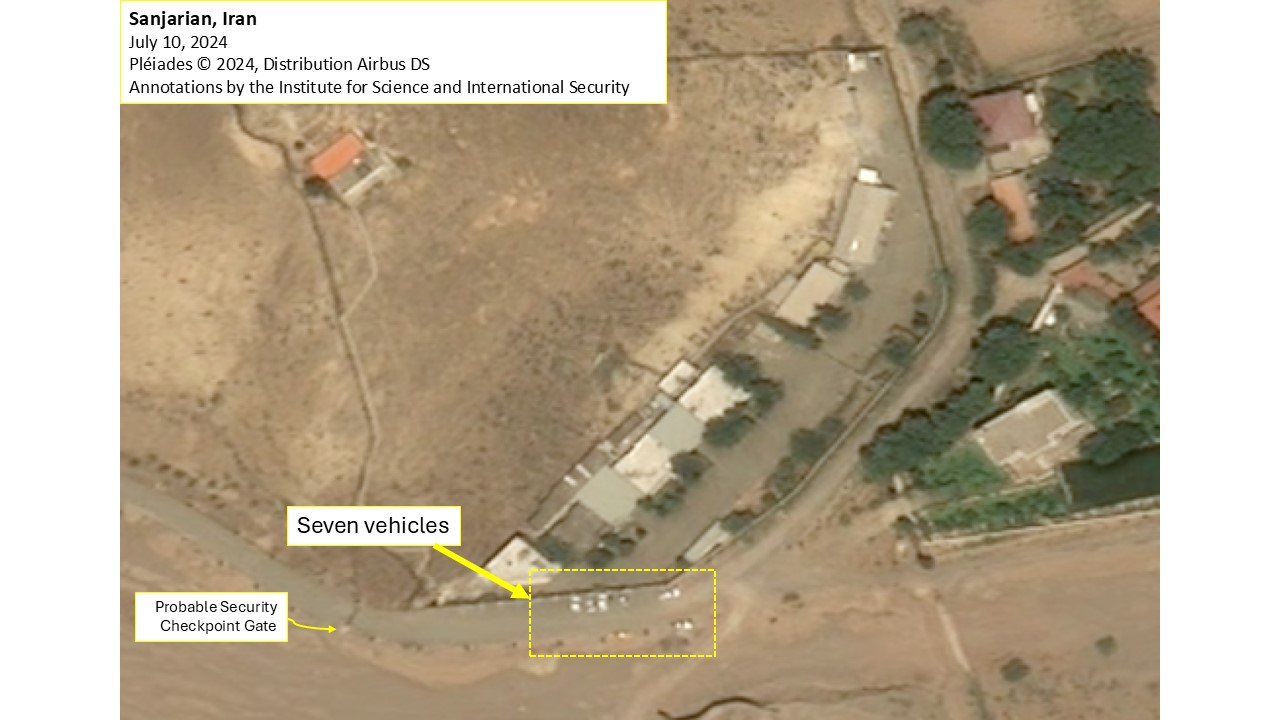
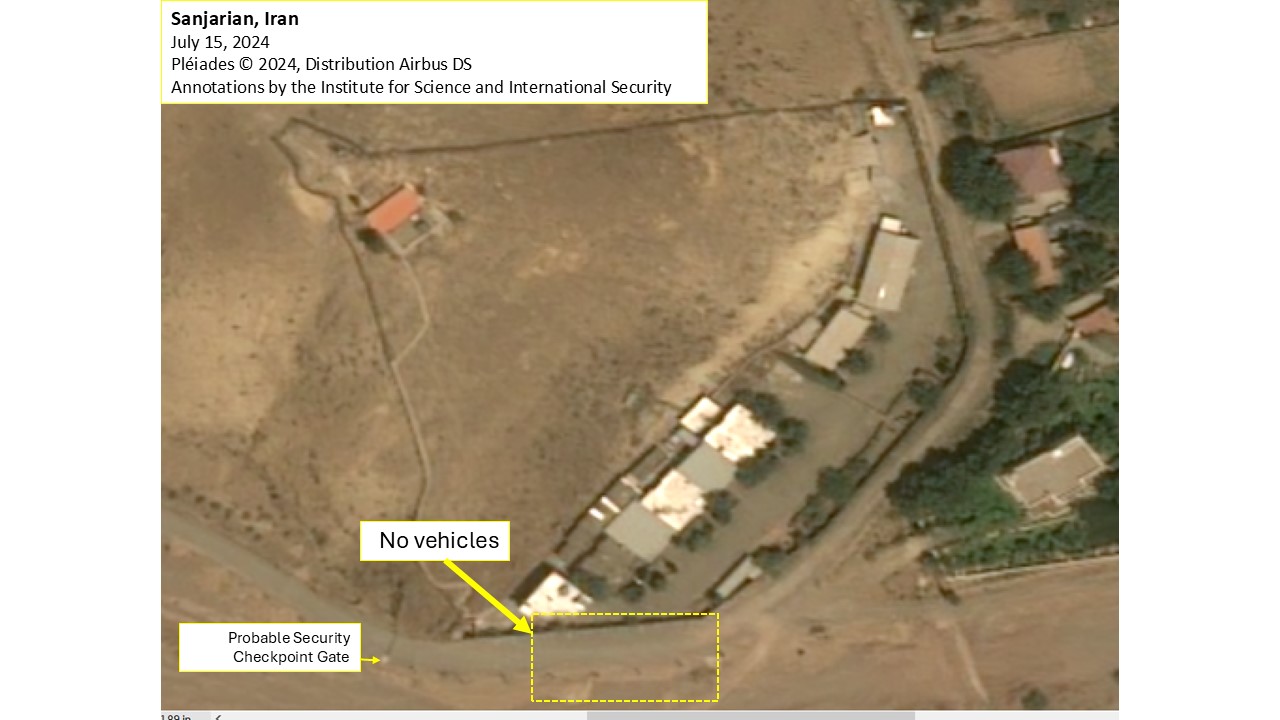
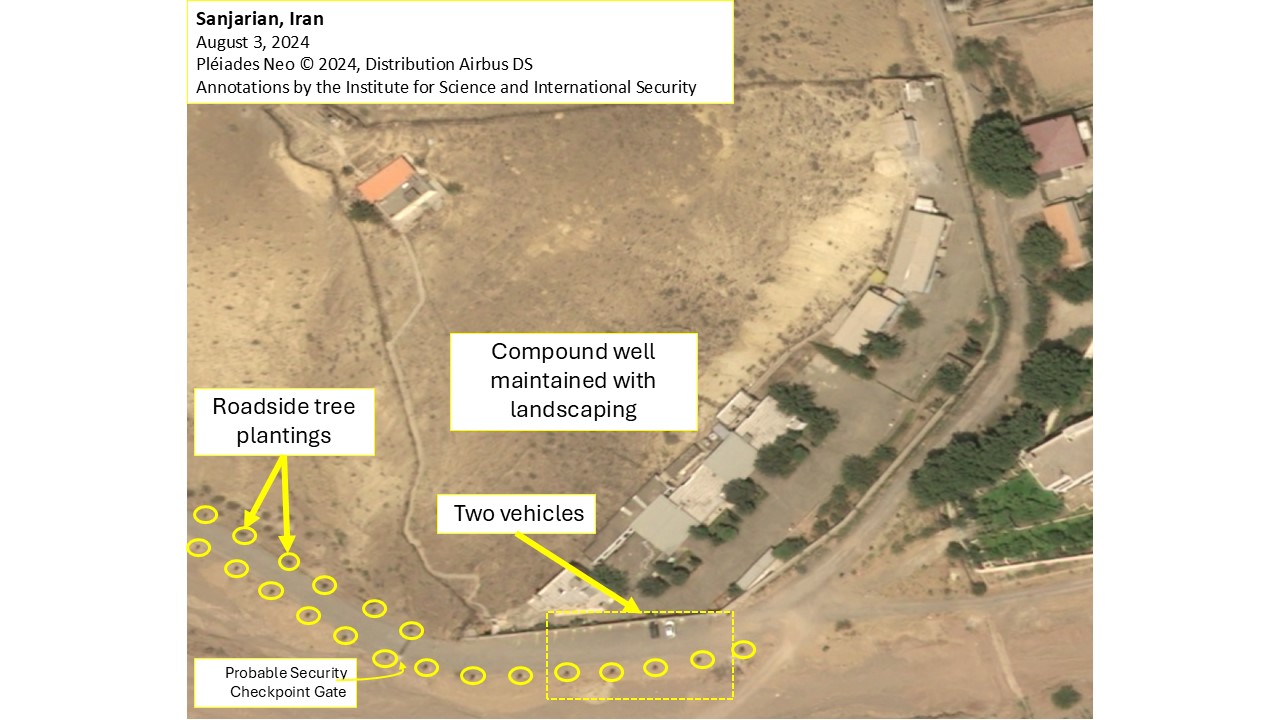
 twitter
twitter